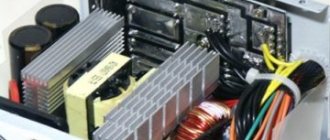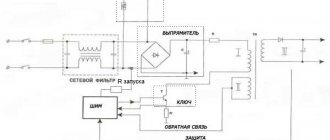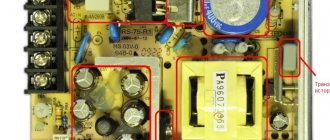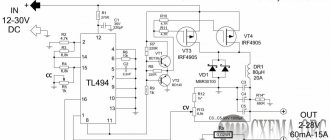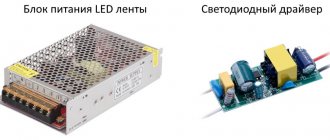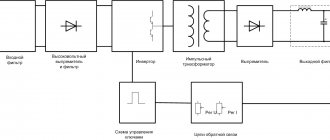In the article “TL494, what kind of “beast” is this?”, we looked at the TL494 PWM controller. In this article we will look at no less, and probably even more common, PWM controllers of the 184x, 284x, 384x series. All these PWM controllers are designed to build switching power supplies for REA, with current and voltage regulation, to control the key stage on an n-channel MOS transistor. In principle, these are the same controllers, differing only in the operating temperature range in which these controllers operate reliably.
The 184x series controllers have the largest operating temperature range, which reaches -55…+125°C. The 284x series controllers have an operating temperature range of -40...+85°C, which is also not bad, and naturally they will all be more expensive than the 384x series controllers, since the smallest operating temperature range is precisely that of the 384x series controllers, which is 0...+70°C, then These controllers are designed primarily for installation in equipment operating indoors. Domestic analogues for these controllers are as follows;
For x842 controllers - KR1033EU10, K1033EU15A, 1114EU7/IM.
For x843 controllers - K1033EU15B, 1114EU8/IM.
For x844 controllers - KR1033EU11, K1033EU16A, 1114EU9/IM.
For x843 controllers - K1033EU16B, 1114EU10/IM.
The operating temperature range of domestic analogues is as follows; For controllers of the 1033EUxx series - ranges from -10 to +70°C. In some “datasheets” the lower operating threshold of these controllers is indicated from 0°C. That is, this series is a complete analogue of the 384x series controllers. For controllers of the 1114EUxx series, the operating temperature range is from -60 to +125 °C
By tradition, let's see what it has inside.
Compound.
It contains:
— 5V reference voltage source with external pin 8; — power supply voltage undervoltage protection circuit (UVLO). — sawtooth voltage generator (generator); — current comparator, used mainly for the current limit signal; — error amplifier, used mainly for voltage; — control circuit for the operation of the output stage;
The UCx844 and UCx845 chips have a built-in counting trigger (indicated by a dotted line), which serves to obtain a maximum duty cycle (PWM duty cycle) of 50%. Therefore, for the master oscillators of these microcircuits, you need to set the switching frequency twice as high as necessary. The UCx842 and UCx843 microcircuit generators are set to the required switching frequency. The maximum operating frequency of the master oscillators of the UCx842/3/4/5 family of controllers can reach 500 kHz. How else do these microcircuits differ from each other? These are different supply voltages for these microcircuits. See the table below;
| ON VOLTAGE – 16 V, OFF – 10 V | ON VOLTAGE – 8.4 V, OFF – 7.6 V | OPERATING TEMPERATURE RANGE | FULL RATIO DUTY CYCLE |
| UC1842 | UC1843 | -55°С… +125°С | up to 100% |
| UC2842 | UC2843 | -40°С… +85°С | |
| UC3842 | UC3843 | 0°С… +70°С | |
| UC1844 | UC1845 | -55°С… +125°С | up to 50% |
| UC2844 | UC2845 | -40°С… +85°С | |
| UC3844 | UC3845 | 0°С… +70°С | |
Also, microcircuits with the suffix “A”, for example UC3842A, have half the trigger current - 0.5 mA. Microcircuits without the “A” suffix have a starting current of about 1.0 mA. Yes, I completely forgot about the microcircuit housings. Here we are mainly considering microcircuits in an eight-pin DIP-8 package (there may be a suffix “N”, or a ceramic CERDIP-8 package (suffix “J”), or a SOIC-8 package (suffix “D8”). The pinouts of the eight-pin microcircuits are completely the same.The microcircuits can also be produced in a 14-pin “SOIC-14” package, with the suffix “D”, and can also be in a “PLCC-20” package (suffix “Q”). The pinouts of the microcircuits in these cases are different. Domestic microcircuits of the 1114 series are made in the H02.8-2B package. This is a ten-pin metal-ceramic package (below in the figure) with five pins on each side, the middle pins of which are simply a technological jumper and not are taken into account, that is, the same eight conclusions are obtained.
Now you can determine by the marking what kind of microcircuit it is, for example UC3843AD; - this is a PWM controller with a reduced startup current (500 μA), with switching on when the supply voltage reaches 8.4 volts and turning off when the supply voltage threshold reaches 7.6 volts, with a duty cycle of up to 100% and is made in the “SOIC” package -14".
The main problems of PWM converters
When operating any device, it is impossible to completely eliminate the possibility of breakdown, and this also applies to converters. The complexity of the design does not matter; even the well-known TL494 PWM controller can cause operational problems. Faults have a different nature - some of them can be detected by eye, while detection of others requires special measuring equipment.
To find out how to check a PWM controller, you should familiarize yourself with the list of main device malfunctions, and only later – with options for eliminating them.
Assignment of microcircuit pins.
Let's now briefly look at the purpose of the pins and the operation of the microcircuit (its blocks), and then see it practically;
1. CMP - error amplifier output. Serves to correct the frequency response of the error amplifier; for this purpose, a capacitor with a capacity of about 100 pF is usually connected between pins 1 and 2. Using this pin, you can set the gain of the error amplifier using an additional resistor, which is connected to the same pins as the capacitor, and also control the operation of the controller. If the voltage at this pin is reduced below 1 volt, then the pulse duration at the output of the microcircuit (pin 6) will decrease, thereby reducing the output voltage (power) of the power supply.
2. VFB - error amplifier feedback input. It is mainly used to regulate (stabilize) the output voltage. If the voltage at this pin exceeds 2.5 volts (supplied from an internal source to the non-inverting input of the error amplifier), then the duration (duty factor) of the output pulses will begin to decrease, thereby reducing the output voltage of the power supply unit.
3. IS - current feedback signal. This pin is usually connected to a resistor in the source circuit of the switching transistor. At the moment the MOS transistor is overloaded, the voltage across the resistor increases and when it increases by more than 1 volt, the pulses at output 6 stop and the output transistor closes.
4. RC is the input of the sawtooth voltage generator and the master RC circuit is connected here to set the frequency of the internal generator. The resistor from this pin is connected to pin 8 - this is the 5 volt reference voltage pin, and the capacitor is connected to the common wire. Basically, in practice, the frequency of the master oscillator is selected in the range of 35...85 kHz, and it is not recommended to use ceramic capacitors in an RC circuit. The generator frequency is calculated using the following formula; — 1.72/R(kOhm) * C(μF).
5. GND - common pin for the primary circuit. This pin should not be directly connected to the common pin of the secondary circuits of the circuit.
6. OUT - output of the PWM controller, connected to the gate switch transistor through a resistor or parallel connected resistor and diode (anode to the gate).
7. VCC - power input of the PWM controller; a supply voltage in the range from 16 volts to 34 is supplied to this pin of the microcircuit. It is not recommended to supply more than 34 volts to the microcircuit, since the microcircuit has overvoltage protection, and if the supply voltage on it exceeds 34 volt - the microcircuit will turn off.
8. REF - output of an internal source of a stable reference voltage of 5 volts, its load current can reach 50 mA.
Components of power supply circuits with PWM controllers
A typical circuit consists of a pulse generator based on a PWM controller. Pulse width modulation makes it possible to manually control the amplitude of the signal at the output of the low-pass filter, changing the pulse duration or its duty cycle if necessary. The strength of PWM is the high efficiency of power amplifiers, especially audio, which in general provides the devices with a fairly wide range of applications.
PWM controllers for power supplies can be used in circuits with different powers. To implement relatively low-power circuits, it is not necessary to include a large number of elements in their composition - an ordinary field-effect transistor can act as a key.
PWM controllers for high-power power supplies can also have output switch controls (drivers). It is recommended to use IGBT transistors as output switches.
How does it all work?
The microcircuit operates in a voltage range from the switch-off threshold to 30 V. To start it, the supply voltage must initially exceed the switch-on threshold. Until the supply voltage reaches the switching threshold, the microcircuit does not work and consumes a small current: less than 500 μA. As soon as the voltage exceeds the switching threshold of the microcircuit, it starts up and all its nodes begin to work. The current consumption of the microcircuit increases to 10-12 mA. When the supply voltage drops to the shutdown threshold, the microcircuit turns off, and its current consumption drops again. The voltage at the VCC pin is limited by the built-in zener diode at 34 V. This makes it possible to start the microcircuit from a high voltage source, for example, rectified mains voltage through a high-resistance resistor Rin, which allows you to organize the initial startup of the microcircuit (without a standby power supply), as shown in the figure below.
Now let's see in practice how this chip works. To do this, we will assemble the following circuit on a breadboard. This is more than enough to test its functionality.
We will power our design from an regulated power supply; we will set the output voltage to around 14-16 volts, which is quite enough. We will monitor the output voltages and signals using an oscilloscope.
We will monitor the output signal at pin 6 of the microcircuit. First, let's put the UC3843 chip on the breadboard and see how the sawtooth voltage generator works and what its output is. We connect the first beam of the oscilloscope to the MS output (pin 6), the second to the sawtooth voltage generator (pin 4). Move variable resistors down the circuit so that the operation of the microcircuit is not affected.
We see that with each pulse of the sawtooth voltage generator, there is one pulse at the output with a duty cycle of about 100% (several percent dead time). That is, the output frequency corresponds to the frequency of the generator. Let's now take the UC3845 chip and compare the output voltage with the 3843.
What do we see? For one output pulse there are two pulses of the sawtooth voltage generator. That is, the output frequency of this microcircuit will be half the frequency of the master oscillator. The duty cycle of the output pulses here is about 50%. Let's now see how current protection works. To do this, we connect the second beam to pin 3 of the microcircuit (the first at the MS output and the zero level of this beam at the second division from the bottom). The zero level of the second beam is at the bottom of the screen below the zero level of the first beam (the beam is at the level of one division).
We set the sensitivity of the second beam to 0.5 volts per division. At pin 3, there is no input voltage yet and there are pulses at the output (pin 6). We begin to increase the input voltage at pin “3”, simulating an increase in current through the output transistor.
What do we see? As soon as the input voltage at pin “3” reached a threshold of 1.0 volts (the beam rose by two divisions), the pulses stopped at the output of the microcircuit. Let's now see how the output voltage of the power supply is adjusted by the microcircuit. For this purpose, we will now connect the second beam to pin “2” of the microcircuit.
There is no input voltage at pin “2”. Pin “6” has output pulses. The sensitivity of the second beam (lower) is set to 1.0 volts per division, it is at the very bottom of the screen. We begin to slowly raise the input voltage at pin “2” of the microcircuit using a variable resistor until there is no change in the output. The lower beam began to rise upward.
What do we see? As soon as the input voltage at pin “2” rose to 2.5 volts, maybe a little higher (the lower beam rose up two and a half divisions), the output pulses at pin “6” stopped. Let's now see what will happen at the output of the error amplifier in the same situation, that is, at pin “1” of the microcircuit. We connect the second beam to pin “1”, set the sensitivity of the beam to 0.5 volts per division, and reduce the voltage at the input (pin “2”) again.
We turn on the power, the input voltage at pin “2” is minimal, at pin “1” the output voltage is around 2.5 volts (the lower beam is raised by five divisions). We begin to gradually increase the voltage at the “2” pin of the microcircuit using a variable resistor. The upper beam crawled down, that is, the voltage at pin “1” began to decrease. Using a variable resistor, we increase the input voltage at pin “2” even more until there are any changes in the output voltage at pin “6”.
That's it, the pulses at the output of the microcircuit have stopped, the first beam is at its zero mark (second division from the bottom), the voltage at pin “1” is about 0.7 volts (the second beam is raised a little more than one division from its zero line).
Now I will try to present everything that we have seen in practice theoretically below. In this microcircuit, voltage stabilization and current protection occur differently than in the TL494 microcircuit we previously reviewed. Here we will not see a smooth change in the width of the output pulses from changes in the input voltage at the input of the error amplifier (pin “2”), or at the input of the current comparator (pin “3”), since the output pulses of the microcircuit (output stage) are controlled by a comparator (current comparator ), and if any thresholds are exceeded, it simply turns off the output stage, and then, when the voltages and currents are normalized, it turns it on. The inverting input of this comparator is internally biased by 1.0 volts. Limitation (disabling) of output pulses occurs if this threshold of 1.0 volts is exceeded at pin “3” of the comparator, or if the voltage at pin “1” is reduced so that it does not exceed the voltage drop across two diodes connected in series (we succeeded about 0.7 volts). The voltage at this pin reaches this value if the input voltage at the input of the error amplifier (pin “2”) exceeds 2.5 volts, because a voltage of 2.5 volts is supplied to the non-inverting input of this error amplifier through internal circuits, that is, it looks like the TL-431 works. Pin “1” can also be used as a second circuit for regulating the output voltage, if, for example, a transistor controlled by an LED (optocoupler) is connected to this output, which is connected to the power supply output. You can also block (emergency shutdown) the microcircuit using this input by connecting it with a transistor or something else to the common wire.
To explain it in a more understandable language, the output voltage (current) is controlled here also by error amplifiers, as in the TL494, the only difference is that in the TL494 the duty cycle of the output pulses changes, but here the control occurs in bursts of output pulses. That is, when the power supply is turned on, pulses appear at the MS output. The voltage at the power supply output begins to increase, and when the set threshold is reached (for example, 12 volts), when the filter capacitor is charged to this voltage, the pulses at the MS output stop. The connected load consumes current and the capacitor discharges. The output voltage begins to decrease and at this moment (after a certain threshold) the MS is turned on and pulses are sent to the output again. After several pulses (a burst of pulses), the capacitor is again recharged to the set threshold and the pulses stop again. If the load current is small, then several pulses are enough to recharge the capacitor (a short burst) and, accordingly, more time passes for the next burst of pulses to be sent to the output (the distance between the bursts of pulses is greater). As the load current increases, a correspondingly greater number of pulses are needed in a burst (long burst) to charge the capacitor, and accordingly the time between bursts of pulses also decreases. If we imagine that a burst of pulses is one pulse (which can be narrower or wider), and the time (distance) between bursts is the time between each pulse, we get a complete analogue of PWM, just like TL494.
The output stage of the microcircuit is made according to a half-bridge circuit and is designed for an average current of about 200 mA, while the peak current can reach 1.0 A and at this level is limited by the microcircuit. The output stage can control both a powerful field-effect and a bipolar transistor.
Well, regarding these microcircuits, that’s basically all I wanted to say. There is a lot written about them on the Internet, and there is a lot of technical documentation. If you want to learn something more about them and in more depth, the search engine is in your hands.
What is PWM?
To obtain a signal of the required shape at the output, the power switch must be opened only for a certain time, proportional to the calculated indicators of the output voltage. This is the principle of pulse width modulation (PWM). Next, a signal of this shape, consisting of pulses varying in width, enters the filter area based on an inductor and a capacitor. After conversion, the output will be an almost ideal signal of the required shape.
The scope of PWM is not limited to switching power supplies, stabilizers and voltage converters. Using this principle when designing a powerful audio amplifier makes it possible to significantly reduce the device's energy consumption, leads to miniaturization of the circuit and optimizes the heat transfer system. The disadvantages include the mediocre quality of the output signal.
